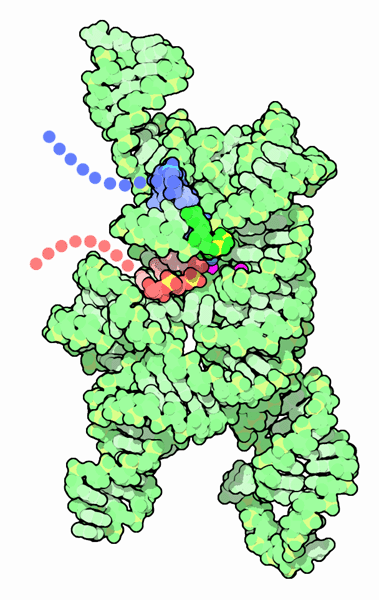|
Inhaltsübersicht | Nanomaschinen | Moleküle | Programme | Kurse | Fun | Links |
||
| > |
Self-splicing RNA

Self-splicing RNA
Nature is full of surprises, and you can be sure that once you think you understand something, Nature will come up with an exception. Twenty years ago, this was the case with enzymes. After decades of work, biochemists thought that proteins were the only molecules that catalyzed chemical reactions in the cell, so it came as a surprise when Thomas Cech and his coworkers discovered a natural RNA splicing reaction that occurs even when all of the proteins are removed. Since then, researchers have discovered many additional examples of ribozymes--RNA molecules that perform chemical tasks.Excising Introns
In plants and animals, most RNA molecules are made as long precursors that need to be trimmed and reassembled to create the final active molecule. These precursor RNA molecules are composed of exons, which are the important parts, separated by introns, which must be removed. In most cases, the RNA is cut and spliced together by a spliceosome, a molecular machine composed of protein and RNA. In a few cases, however, the RNA can perform the splicing reaction on its own. The first example, discovered by Thomas Cech, was a ribosomal RNA found in a protozoan. Since then, hundreds of examples have been identified in genome sequences of many organisms. The example shown here, from PDB entry 1u6b, is part of a bacterial transfer RNA that must be spliced before it can adopt its functional form. In the illustration, the large structure in green is the intron, which uses a GTP and two magnesium ions to remove itself. The two exons that will be spliced together are colored red and blue--note that only a small piece of each exon is included in the structure.Ribozymes Everywhere
Once researchers started looking, ribozymes turned up everywhere. In some cases, they are built into RNA molecules and act upon themselves, as in the self-splicing introns. In other cases, ribozymes act on other RNA molecules, breaking and rejoining the phosphate bonds that hold the chains together. In some ribozymes, such as the spliceosome and ribonuclease P (which processes transfer RNA and other RNA molecules), the RNA works along with proteins to perform the reaction. Most ribozymes perform cutting and pasting reactions on RNA, however, the ribosome (which is thought to be a ribozyme) shows that RNA can also perform other reactions, such as the formation of peptide bonds in proteins.Next: The Smallest Ribozyme
Last changed by: A.Honegger,